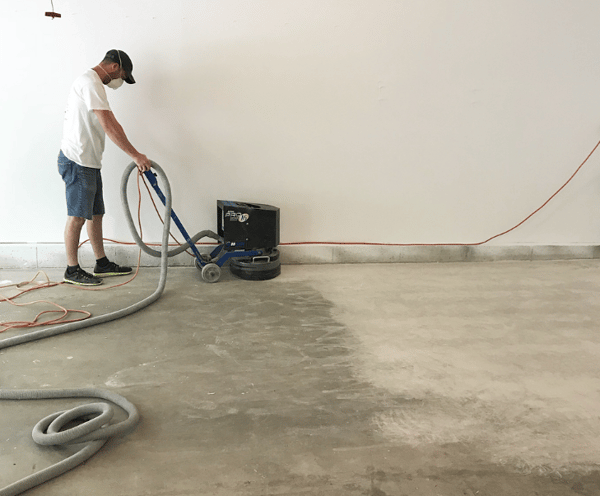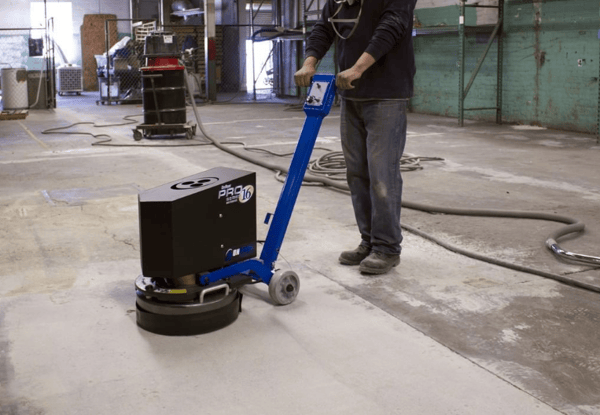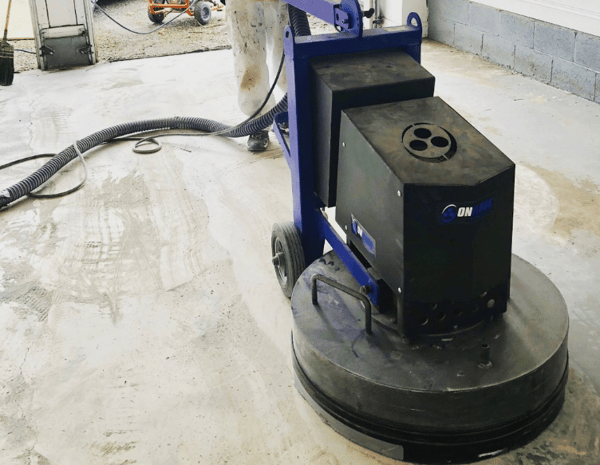Whether you're a homeowner stepping into a renovation project or a seasoned professional in the construction industry, understanding the specifics of concrete surface preparation is crucial. Among the multifaceted techniques in this domain, concrete sanding stands out as a pivotal method for achieving smooth and prepared surfaces. The use of industrial grinders has revolutionized this practice, making it not just a standard procedure but an art to perfect.
In this extensive guide, we're going to drill down into what concrete sanding encompasses, why it's essential for both longevity and aesthetics, and how innovations like the Onfloor's quick-change tooling system are changing the game.
This isn't just another post; it's an indispensable resource for transforming the way you approach concrete work…
Unveiling the Purpose of Concrete Sanding
The term 'concrete sanding' is often thrown around without fully understanding its intricacies. At its core, concrete sanding is about refining existing concrete surfaces to a desired level of smoothness, enhancing adhesion for sealants, coatings, or overlays. This method is particularly important in the lifecycle of any concrete structure, be it a sidewalk, a kitchen floor, or an industrial warehouse.
The process requires precision and power, as the goal is to eliminate irregularities such as surface pits, divots, and rough textures that can make applying subsequent materials challenging. With concrete sanding, the adage 'start with a strong foundation' echoes particularly loudly, as a sound foundation here leads to a lasting smooth finish.
The Intricacies of Sanding Concrete
Concrete sanding goes beyond mere smoothing; it's part of a hierarchy of surface preparation methods that includes grinding, scarifying, and shot blasting. When you're sanding concrete, you're essentially removing a thin layer from the top of the slab – usually around 1/16th of an inch – cleaning it thoroughly, and leaving it velvety smooth.
This delicate process is achieved through the use of heavy-duty industrial grinders. With capabilities to polish, refinish, and level concrete surfaces, these machines have become indispensable in achieving quality work that stands the test of time.

The Step-by-Step Guide to Concrete Sanding
Concrete sanding may seem straightforward but is surprisingly detailed. Here, we're breaking it down into essential steps, outlining what you can expect when you set out to sand a concrete surface.
Step 1: Surface Inspection and Preparation
The first task is to check the concrete for any damage or signs of decay. Addressing these issues beforehand will prevent the spread of any deterioration under new coatings. Then, it's vital to clear the area and protect adjacent surfaces from dust and debris using tape and drop cloths.
Step 2: Coarse Grinding with Diamond Tooling
Here's where the real work begins. Coarse diamond tooling is used to grind away the top layer of the concrete. This step tackles the major imperfections and sets the groundwork for finer finishing. It's like grit sandpaper or the rough sandpaper used in woodworking – necessary for preparing the canvas for finer detail.
Step 3: Medium Grinding for Smoothing
The next round involves medium-grade tooling, which reduces the rough texture left by the coarse grinding. This step refines the surface further, making it uniform and ready for the next phase.
Step 4: Fine Grinding and Polishing
Finally, fine-grade diamond tooling is used to polish the concrete to a satin or high-gloss finish. This step is optional but highly recommended, as it not only makes the surface more aesthetically pleasing but also densifies the concrete's surface throughout, adding to its durability.
A crucial time-saving technology that Onfloor provides is the quick change tooling system. Traditionally, tool or wheel changeovers could consume a significant portion of your workday. Onfloors system, on the other hand, lets you shift from grinding to polishing or different grits in under 60 seconds, ensuring you maximize productivity without compromising quality.
The Benefits of Concrete Sanding with Industrial Grinders
The rewards of adopting concrete sanding as a standard procedure are varied, ranging from a cosmetic overhaul to substantial safety enhancements.
Enhanced Aesthetics and Longevity
Sanding concrete not only beautifies the surface but also increases its lifespan. By removing the top layer of concrete finish, any damage or wear and tear is displaced, and the virgin layer of concrete underneath is brought forth.
This pristine layer is effectively a new surface, unencumbered by previous issues that may have led to a need for replacement. Aesthetic enhancements from polishing are compounded by a tougher surface that resists abrasion and corrosion, adding both value and resilience to the structure.
Cost-Effectiveness Over Replacement
Sanding is considerably more cost-effective than the wholesale replacement of a concrete structure. With grinders, you're able to salvage concrete that may still be structurally sound but aesthetically worn. This economic approach is a triple win: conserving resources, saving on labor, and avoiding the hassles of demolition and reconstruction.
Safety First: Reducing Slip Hazards
The smoothness achieved through sanding isn't just for looks. It significantly reduces the risk of slips and falls, making sanded floors ideal for high-traffic areas such as garage floors where safety is paramount. Eliminating rough spots and surface imperfections ensures a level playing field, quite literally, for your flooring.

Concrete Sanding in Real-World Scenarios
Concrete sanding isn't just for monolithic structures like skyscrapers; its applications are diverse and vital in a myriad of scenarios.
Residential and Commercial Flooring Projects
From designer residential floors to expansive commercial spaces, concrete sanding plays a key role in delivering sophisticated yet robust flooring solutions. With the growing popularity of polished concrete, residential and commercial spaces are shifting towards more sustainable and low-maintenance concrete floor options.
Outdoor and Industrial Concrete Surfaces
The need for durability and resistance to environmental factors is high for outdoor concrete surfaces. Sanding helps weatherproof these surfaces, making them less prone to flaking or chipping, thus extending their shelf life.
Restoration Projects
When it comes to restoring heritage structures or breathing new life into decrepit buildings, concrete sanding paves the way. It allows for reconditioning without losing the charm of exposed concrete, which is increasingly a hallmark of modern industrial design.
FAQs
Q: How long does it take to sand concrete?
A: The time required for concrete sanding depends on the size and condition of the surface, as well as the equipment used. Generally, it can take anywhere from a few hours to a full day.
Q: Can I sand concrete by hand?
A: While small areas can be sanded by hand, larger surfaces are best tackled with industrial grinders for efficiency and quality results.
Q: Do I need to seal or coat the concrete after sanding?
A: Yes, it is recommended to apply concrete sealant or coat the concrete after sanding to protect it from stains and wear. This can also enhance the appearance of the surface.
Q: What is the difference between sanding and polishing concrete?
A: Sanding involves using coarse and fine-grade diamond tooling to remove imperfections from the surface, while polishing involves further refining the surface for a smooth and shiny finish.
Q: Is concrete sanding a messy process?
A: Yes, it can be messy due to the dust and debris generated. It is important to take precautions such as using protective gear and covering adjacent surfaces.
Q: Can I choose the level of gloss for polished concrete?
A: Yes, you can select from varying levels of gloss depending on your preference and the intended use of the surface.

Q: How often should I sand and polish my concrete floors?
A: This depends on factors such as foot traffic, maintenance, and the type of sealant or coating used. Generally, concrete floors can be sanded and polished every 3-5 years for maintenance.
Q: Can I remove stains and blemishes from concrete through sanding?
A: Yes, sanding can effectively remove surface stains and blemishes, restoring the appearance of the concrete.
Q: Can I sand and polish colored concrete?
A: Yes, colored concrete can be sanded and polished just like regular concrete. However, care must be taken not to damage or change the color during the sanding process.
Q: Is concrete sanding environmentally friendly?
A: Yes, by improving the lifespan of concrete and avoiding the need for replacement, sanding is an eco-friendly option for maintaining concrete surfaces.
Final Thoughts
Concrete sanding, when done right, is a testament to human ingenuity's ability to refine even the most rugged of materials. In your pursuit of perfect sanded concrete surfaces, remember that the tools you use can be just as important as the methods you follow.
If you're ready to elevate your concrete sanding game, consider exploring industrial grinders and accessories that not only save time but also deliver superior results. With the right equipment and knowledge, you'll be at the cutting edge of the future of concrete work.
If you found this guide illuminating and you're eager to dig deeper into the world of concrete sanding, don't hesitate to reach out to us at Onfloor. We're passionate about helping professionals and enthusiasts alike unlock the potential in every project they undertake.
Start your concrete transformation today with Onfloors industry-leading equipment and expertise. Your surfaces will thank you – and stand the test of time because of it.
0 comments